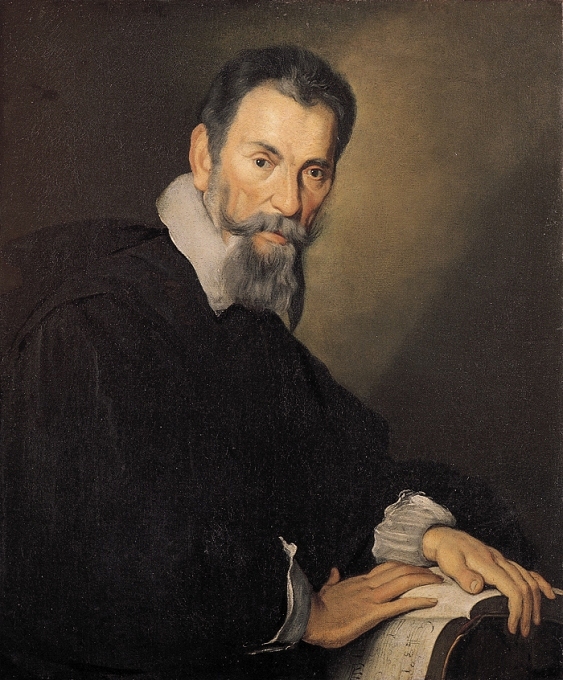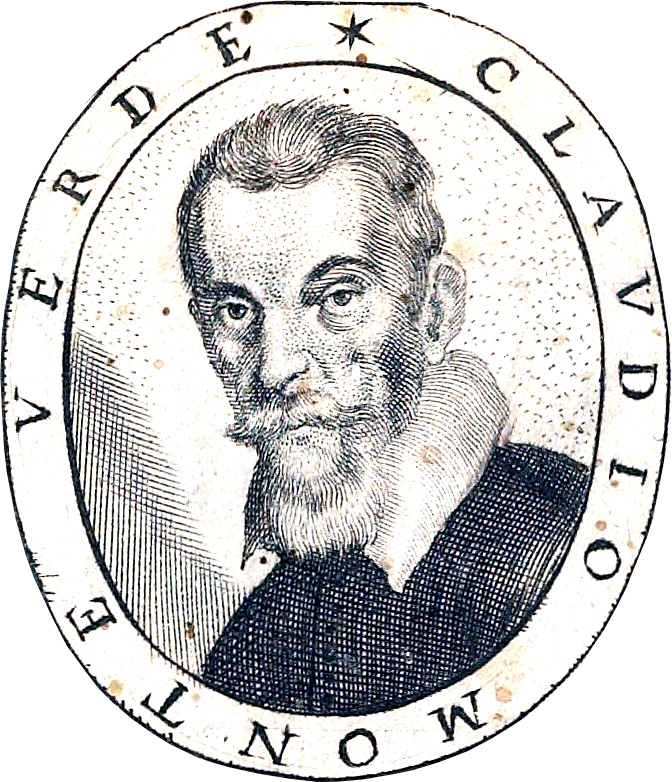1.27: Claudio Monteverdi
- Page ID
- 72520
We will study Claudio Monteverdi in both the Renaissance and Baroque periods. His music, especially his madrigals, demonstrates the transition from late Renaissance to early Baroque style. His first four books of madrigals feature the late Renaissance style that you hear in “Ecco mormorar l’onde.” Starting with the fifth book of madrigals, he adopts the new practices that we’ll come to know as early Baroque style.
Introduction

Claudio Giovanni Antonio Monteverdi (15 May 1567 (baptized)–29 November 1643) was an Italian composer, gambist, singer and Roman Catholic priest.
Monteverdi’s work, often regarded as revolutionary, marked the change from the Renaissance style of music to that of the Baroque period. He developed two styles of composition—the heritage of Renaissance polyphony and the new basso continuo technique of the Baroque. Monteverdi wrote one of the earliest operas, L’Orfeo, a novel work that is the earliest surviving opera still regularly performed. He is widely recognized as an inventive composer who enjoyed considerable fame in his life-time.
Life
Claudio Monteverdi was born in 1567 in Cremona, Lombardy. His father was Baldassare Monteverdi, a doctor, apothecary and amateur surgeon. He was the oldest of five children. During his childhood, he was taught by Marc’Antonio Ingegneri, the maestro di cappella at the Cathedral of Cremona. The Maestro’s job was to conduct important worship services in accordance with the liturgy of the Catholic Church. Monteverdi learned about music as a member of the cathedral choir. He also studied at the University of Cremona. His first music was written for publication, including some motets and sacred madrigals, in 1582 and 1583. His first five publications were: Sacrae cantiunculae, 1582 (a collection of miniature motets); Madrigali Spirituali, 1583 (a volume of which only the bass partbook is extant); Canzonette a tre voci, 1584 (a collection of three-voice canzonettes); and the five-part madrigals Book I, 1587, and Book II, 1590. He worked at the court of Vincenzo I of Gonzaga in Mantua as a vocalist and viol player, then as music director. In 1602, he was working as the court conductor and Vincenzo appointed him master of music on the death of Benedetto Pallavicino.
In 1599 Monteverdi married the court singer Claudia Cattaneo, who died in September 1607. They had two sons (Francesco and Massimilino) and a daughter (Leonora). Another daughter died shortly after birth. In 1610 he moved to Rome, arriving in secret, hoping to present his music to Pope Paul V. His Vespers were printed the same year, but his planned meeting with the Pope never took place.
In 1612 Vincenzo died and was succeeded by his eldest son Francesco. Heavily in debt, due to the profligacy of his father, Francesco sacked Monteverdi and he spent a year in Mantua without any paid employment. His 1607 opera L’Orfeo was dedicated to Francesco. The title page of the opera bears the dedication “Al serenissimo signor D. Francesco Gonzaga, Prencipe di Mantoua, & di Monferato, &c.”

By 1613, he had moved to San Marco in Venice where, as conductor, he quickly restored the musical standard of both the choir and the instrumentalists. The musical standard had declined due to the financial mismanagement of his predecessor, Giulio Cesare Martinengo. The managers of the basilica were relieved to have such a distinguished musician in charge, as the music had been declining since the death of Giovanni Croce in 1609.
In 1632, he became a priest. During the last years of his life, when he was often ill, he composed his two last masterpieces: Il ritorno d’Ulisse in patria (The Return of Ulysses, 1641), and the historic opera L’incoronazione di Poppea (The Coronation of Poppea, 1642), based on the life of the Roman emperor Nero. L’incoronazione especially is considered a culminating point of Monteverdi’s work. It contains tragic, romantic, and comic scenes (a new development in opera), a more realistic portrayal of the characters, and warmer melodies than previously heard. It requires a smaller orchestra, and has a less prominent role for the choir. For a long period of time, Monteverdi’s operas were merely regarded as a historical or musical interest. Since the 1960s, The Coronation of Poppea has re-entered the repertoire of major opera companies worldwide.
Monteverdi died, aged 76, in Venice on 29 November 1643 and was buried at the church of the Frari.
Madrigals
Until the age of forty, Monteverdi worked primarily on madrigals, composing a total of nine books. It took Monteverdi about four years to finish his first book of twenty-one madrigals for five voices. As a whole, the first eight books of madrigals show the enormous development from Renaissance polyphonic music to the monodic style typical of Baroque music.
Listen
Cor mio mentre vi miro
An audio element has been excluded from this version of the text. You can listen to it online here: http://pb.libretexts.org/map/?p=96
The titles of his Madrigal books are:
- Book 1, 1587: Madrigali a cinque voci
- Book 2, 1590: Il secondo libro de madrigali a cinque voci
- Book 3, 1592: Il terzo libro de madrigali a cinque voci
- Book 4, 1603: Il quarto libro de madrigali a cinque voci
- Book 5, 1605: Il quinto libro de madrigali a cinque voci
- Book 6, 1614: Il sesto libro de madrigali a cinque voci
- Book 7, 1619: Concerto. Settimo libro di madrigali
- Book 8, 1638: Madrigali guerrieri, et amorosi con alcuni opuscoli in genere rappresentativo, che saranno per brevi episodi fra i canti senza gesto.
- Book 9, 1651: Madrigali e canzonette a due e tre voci
The Fifth Madrigal Book
Listen
Cruda Amarilli
An audio element has been excluded from this version of the text. You can listen to it online here: http://pb.libretexts.org/map/?p=96
The Fifth Book of Madrigals shows the shift from the late Renaissance style of music to the early Baroque. The Quinto Libro (Fifth Book), published in 1605, was at the heart of the controversy between Monteverdi and Giovanni Artusi. Artusi attacked the “crudities” and “license” of the modern style of composing, centering his attacks on madrigals (including Cruda Amarilli, composed around 1600) (See Fabbri, Monteverdi, p. 60) from the fourth book. Monteverdi made his reply in the introduction to the fifth book, with a proposal of the division of musical practice into two streams, which he called prima pratica, and seconda pratica. Prima pratica was described as the previous polyphonic ideal of the sixteenth century, with flowing strict counterpoint, prepared dissonance, and equality of voices. Seconda pratica used much freer counterpoint with an increasing hierarchy of voices, emphasizing soprano and bass. In Prima pratica the harmony controls the words. In Seconda pratica the words should be in control of the harmonies. This represented a move towards the new style of monody. The introduction of continuo in many of the madrigals was a further self-consciously modern feature. In addition, the fifth book showed the beginnings of conscious functional tonality.
Contributors and Attributions
- Authored by: Elliott Jones. Provided by: Santa Ana College. Located at: http://www.sac.edu. License: CC BY: Attribution
- Claudio Monteverdi. Provided by: Wikipedia. Located at: http://en.Wikipedia.org/wiki/Claudio_Monteverdi. License: CC BY-SA: Attribution-ShareAlike

